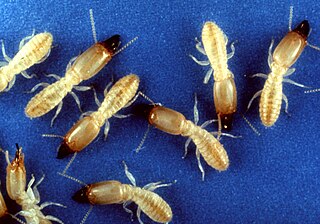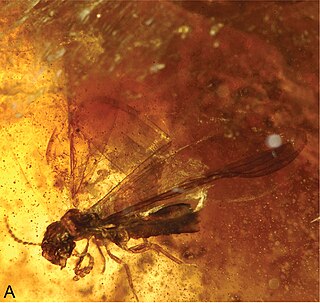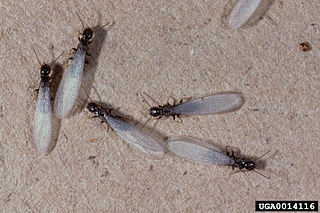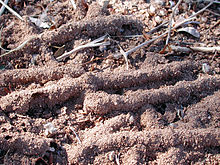
Termites are a group of detritophagous eusocial insects which consume a wide variety of decaying plant material, generally in the form of wood, leaf litter, and soil humus. They are distinguished by their moniliform antennae and the soft-bodied and typically unpigmented worker caste for which they have been commonly termed "white ants"; however, they are not ants, to which they are distantly related. About 2,972 extant species are currently described, 2,105 of which are members of the family Termitidae.

Reticulitermes flavipes, the eastern subterranean termite, is the most common termite found in North America. These termites are the most economically important wood destroying insects in the United States and are classified as pests. They feed on cellulose material such as the structural wood in buildings, wooden fixtures, paper, books, and cotton. A mature colony can range from 20,000 workers to as high as 5 million workers and the primary queen of the colony lays 5,000 to 10,000 eggs per year to add to this total.

Mastotermes darwiniensis, common names giant northern termite and Darwin termite, is a termite species found only in northern Australia. It is the most primitive extant termite species. Contrary to common belief, this species does not form mounds as the nests are subterranean and inconspicuous. Colonies will readily occupy and infest decomposing wood but primarily live in a complex subterranean network of tunnels and galleries which they use to travel to new food sites. Colonies may eventually split and form isolated satellite colonies.

Termitidae is the largest family of termites consisting of 2,105 described species of which are commonly known as the higher termites. They are evolutionarily the most specialised termite group, with their highly compartmentalized hindgut lacking the flagellated protozoans common to "lower termites", which are instead replaced by bacteria. Whereas lower termites are restricted mostly to woody tissue, higher termites have diverse diets consisting of wood, grass, leaf litter, fungi, lichen, faeces, humus and soil. Around 60% of species rely on soil-feeding alone.

Kalotermitidae is a family of termites, commonly known as drywood termites. Kalotermitidae includes 21 genera and 419 species. The family has a cosmopolitan circumtropical distribution, and is found in functionally arid environments.

Coptotermes gestroi, commonly known as the Asian subterranean termite is a small species of termite that lives underground. Both this species and the Formosan subterranean termite are destructive pests native to Asia, but have spread to other parts of the world including the United States. In Asia, this species is known as the Philippine milk termite.

Mastotermes is a genus of termites. The sole living species is Mastotermes darwiniensis, found only in northern Australia. A number of extinct taxa are known from fossils. It is a very peculiar insect, the most primitive termite alive. As such, it shows notable similarities to cockroaches in the family Cryptocercidae, the termites' closest relatives. These similarities include the anal lobe of the wing and the laying of eggs in bunches, rather than singly. The termites were traditionally placed in the Exopterygota, but such an indiscriminate treatment makes that group a paraphyletic grade of basal neopterans. Thus, the cockroaches, termites and their relatives are nowadays placed in a clade called Dictyoptera.

Amitermes is a genus of termites in the family Termitidae. Species are found in a range of habitats including deserts and rainforests. Characteristics of Amitermes soldiers include a bulbous head, sickle-shaped mandibles with a single tooth on their inner margins and cephalic glands on the front of their heads.
Ahamitermes is a genus of termites in the family Termitidae containing four species, all of which have a parasitic relationship with termites in the genus Coptotermes. The host and the parasite dwell in separate parts of the mound nest and are mutually antagonistic. The Ahamitermes live in the innermost parts of the nest and feed on the "carton" material with which the galleries are lined which consists of soil particles, chewed wood and cellulose, bound together with saliva and faeces. They are thus dependent on their host for both their food and their home and are not found in any other situations. The genus was first described in 1920 by Eric Mjöberg.

Coptotermes is a genus of termites in the family Rhinotermitidae. Many of the roughly 71 species are economically destructive pests. The genus is thought to have originated in Southeast Asia. Worker termites from this genus forage underground and move about in roofed tunnels that they build along the surface.

Termitinae is a subfamily of termites; Amitermes and certain other genera have previously been placed in the Amitermitinae, with some workers arguing that the latter have morphologically distinct characteristics and "some important attributes that affect soil".
Heterotermes indicola, is a species of subterranean termite of the genus Heterotermes. It is native to tropical India, Pakistan and Sri Lanka but has extended its range into the subtropics and warm temperate areas of the Himalayan foothills to altitudes of about 2,000 m (6,600 ft). It causes damage to timber in buildings and is one of the most destructive termites in urban and agricultural areas in the world. Soldiers are about 4.1-4.9mm long. Extracts of garlic and Calotropis procera are known to have termiticidal effects on H. indicola.

Blattoidea is a superfamily of cockroaches and termites in the order Blattodea. There are about 17 families and more than 4,100 described species in Blattoidea.

Gnathamitermes perplexus, the long-jawed desert termites or tube-building termites, is a species of termite in the family Termitidae. It is found in Central America and North America. The species creates tunnels, with both colony founders and workers transporting sand to excavate tunnels using their mandibles. The species is particularly susceptible to infectious nematodes such as Steinernema riobrave.

Reticulitermes virginicus is a species of subterranean termite native to North America, found often in the southern United States. It was described in 1907.
Amitermes floridensis, commonly known as the Florida darkwinged subterranean termite, is a species of eusocial insect in the family Termitidae. It feeds on rotting wood, reached by a network of tunnels. It is endemic to west central Florida and was first described in 1989.
Coptotermes heimi is a species of termite in the family Rhinotermitidae. It is found in India, Pakistan and Bangladesh and lives wholly underground.

Syntermes is a genus of large Neotropical higher termites within the subfamily Syntermitinae. The genus is found only in South America where members are distributed widely throughout the continent, being found from the tropical rainforests of Colombia to the savannas of Brazil and Northern Argentina.
Heterotermes aureus, commonly known as the desert subterranean termite, is a species of termite in the family Rhinotermitidae. It is native to the deserts of North America where the colony has an underground nest.
The Syntermitinae, also known as the mandibulate nasutes, is a Neotropical subfamily of higher termites represented by 21 genera and 103 species. The soldier caste of members of this subfamily have a conspicuous horn-like projection on the head which is adapted for chemical defense, similar to the fontanellar gun of true nasute termites. However unlike true nasutes, the mandibles of the soldiers are functional and highly developed, and they are unable to expel their chemical weaponry at a distance – instead relying on direct physical contact. Some genera, such as Syntermes or Labiotermes, have a highly reduced nasus and in some species it may appear absent altogether. Although the Syntermitinae were once grouped and considered basal within the Nasutitermitinae, they are not closely related with modern cladistic analyses showing Syntermitinae to be a separate and distinct lineage that is more closely related to either the Amitermes-group or MicrocerotermesTermitinae. It is believed the nasus evolved independently in Syntermitinae in an example of convergent evolution. Genera range from southern Mexico (Cahuallitermes) to Northern Argentina with the highest diversity occurring in the Brazilian Cerrado.













